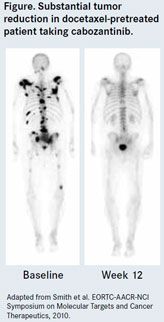Article
Bone-Targeted Therapeutics
Author(s):
Initial clinical findings indicate that results with radiotherapies sometime improve when combined with immunotherapy

Therapies that target bone metastases have been developed for more than a decade, from the approval of zolendronic acid (Zometa®) in 2001 to more the more recent approval of denosumab (XgevaTM) last year.
At the 2011 Interdisciplinary Prostate Cancer Congress (IPCC), A. Oliver Sartor, MD, medical director, Tulane Cancer Center in New Orleans, LA, spoke about these approved therapies and other therapies now in clinical trials.
The first investigational agent he discussed was radium-223 (Alpharadin), a bone-seeking radionucleotide, which is being tested in the ALpharadin in SYMptomatic Prostate CAncer(ALSYMPCA) trial. This is a phase 3 trial for patients with bone metastases from hormone-refractory prostate cancer. Sartor called the radiotherapy “a little nuclear bomb that destroys tumor cells with less toxicity.” He explained: “I think that it is because of the very short radius of the destruction. The alpha particle has higher energy but much shorter radiation range than a beta particle.”
A phase 2 trial studied patients who were given 4 intravenous (IV) injections of radium-223 (33 patients) or placebo (31 patients), administered every 4 weeks. Hazard ratio (HR) for time to first skeletal-related event (SRE), adjusted for baseline, was 1.75. Hematologic toxic effects did not differ significantly between the 2 groups, and no patient discontinued radium-223 because of treatment toxicity. Median time to prostate-specific antigen (PSA) progression was 26 weeks for the patients who received radium-223 versus 8 weeks for the placebo patients. Median overall survival (OS) was 65.3 weeks and 46.4 weeks, respectively. Hazard ratio for OS, adjusted for baseline covariates, was 2.12.
These initial clinical findings indicate that results with radiotherapies sometime improve when combined with immunotherapy, according to Sartor. For example, the National Cancer Institute released results last year from a randomized trial of samarium-153 external beam radiation therapy (EBRT) and the investigational vaccine PROSTVAC®-VF to determine if prostate cancer patients can obtain better responses. Pretreatment and posttreatment serum samples from patients treated with the vaccine and EBRT were evaluated by Western blotting, which revealed treatment-associated autoantibody responses in 15 of 33 (45.5%) patients treated with vaccine plus EBRT versus 1 of 8 (12.5%) treated with EBRT alone.“There is a lot of compelling evidence now about interactions between radiation and immunology that I think we will see on the horizon,” Sartor said.
Sartor also discussed cabozantinib (XL184), a small molecule designed to inhibit multiple receptor tyrosine kinases, specifically MET and vascular endothelial growth factor receptor-2 (VEGFR-2). MET is a receptor tyrosine kinase that plays key roles in cellular proliferation, migration, and invasion, as well as in angiogenesis. It is highly expressed in prostate bone metastases. Docetaxel-pretreated patients have experienced substantial tumor reduction during therapy with cabozantinib, 12 weeks after the agent was introduced. While one patient does not tell the entire story, Sartor said that a whole series of patients have experienced similarly promising results in clinical trials. A phase 2 clinical trial is now recruiting adults with advanced malignancies.









